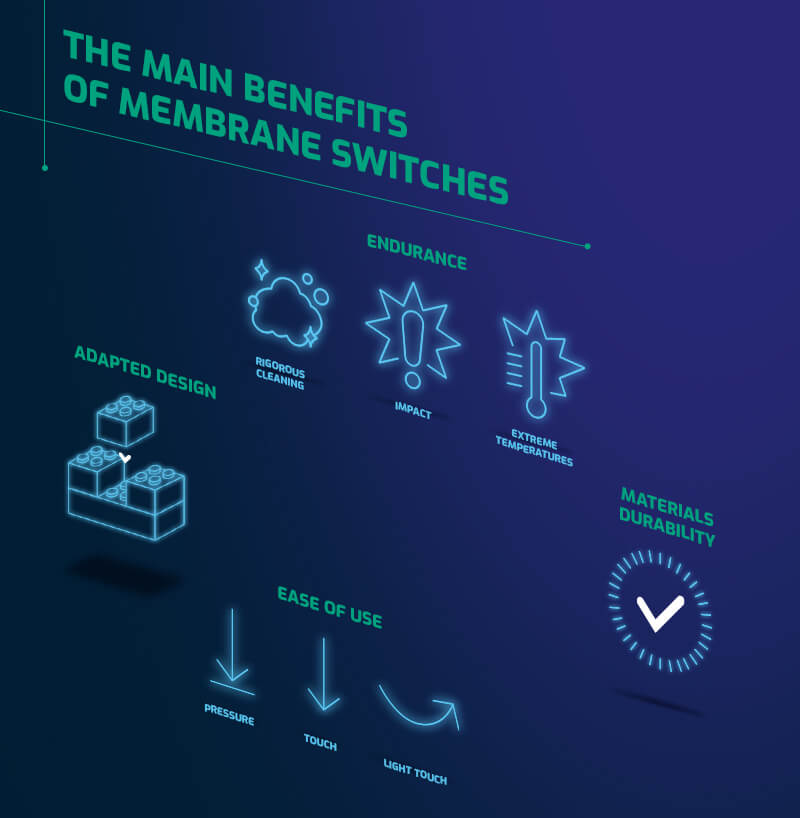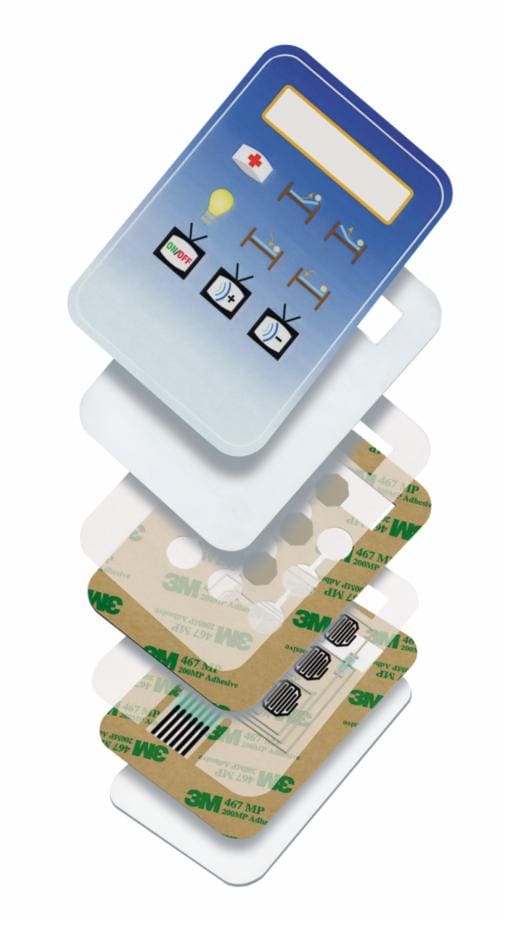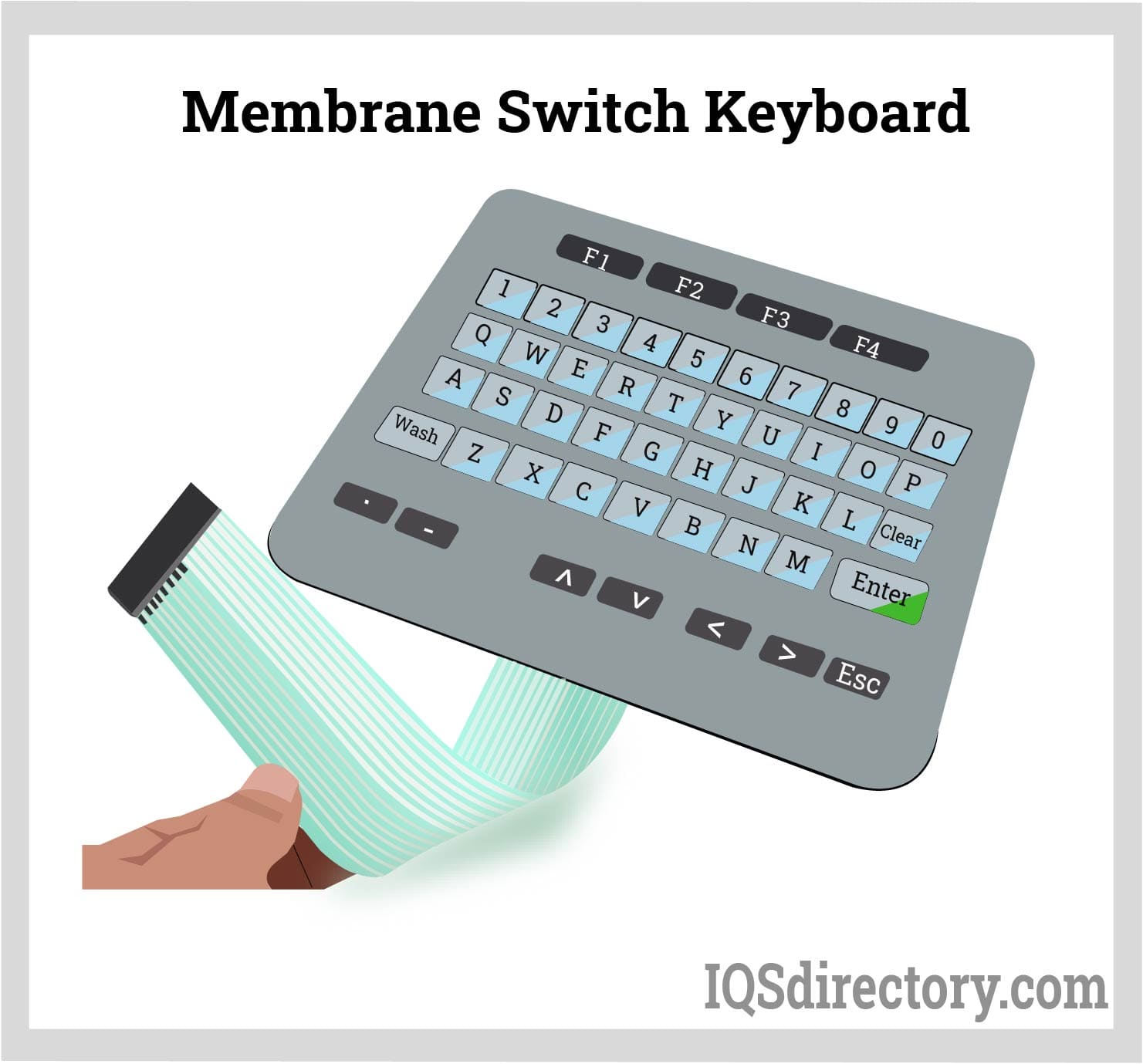The Manufacturing Refine Behind Membrane Switch Over: What You Required to Know
The manufacturing procedure behind membrane switches over combines careful layout, material option, and quality assurance. It begins with understanding the complexities of membrane layer switch layout and progresses via different phases, including product choices and printing methods. Each phase plays a crucial function in making certain performance and durability. The complexities of layer building and the strenuous testing requirements might reveal insights that are not immediately evident. What exists beyond these foundational aspects?
Recognizing Membrane Switch Style
Although membrane layer switches may appear basic initially glance, their style includes detailed factors to consider that guarantee performance and toughness. The layout procedure starts with a detailed understanding of user requirements, including the interface's intended application and environmental elements. Ergonomics is a crucial element, as the design should assist in simplicity of use while guaranteeing that tactile feedback meets user expectations.Moreover, the layering of components, such as visuals overlays, glue layers, and conductive traces, have to be specifically crafted. membrane switch. This layered configuration not only affects the button's responsiveness however likewise influences its durability. Attention is offered to the sealing strategies employed to protect versus dampness and dust, which could endanger efficiency. Furthermore, design factors to consider include visual appeals, where color pattern and aesthetic quality enhance user experience. Eventually, the design of membrane layer switches equilibriums capability, user experience, and sturdiness, making certain that they meet the needs of various applications properly
Materials Made Use Of in Membrane Layer Change Production
When selecting products for membrane button manufacturing, it is important to contemplate both efficiency and longevity. The primary materials consist of polyester and polycarbonate movies, which offer adaptability and toughness. These films are often covered with adhesive to ensure proper bonding to substratums. Conductive inks, generally made up of silver or carbon, are crucial for developing electrical links within the switch, enabling dependable operation.Additionally, a safety layer, such as a hard layer, is frequently applied to boost scratch resistance and durability. The selection of backing material, such as acrylic or foam, can substantially impact the switch's responsive feeling and overall individual experience. Numerous environmental elements, consisting of temperature and humidity, ought to assist product selection to guarantee peak performance in certain applications. Inevitably, the appropriate combination of materials adds to the membrane switch's functionality and lifespan, making informed selections vital for makers.
The Printing Refine: Creating Graphics and Text
The printing process in membrane button production plays a significant duty in creating high-grade graphics and message. Various graphic design techniques are employed to guarantee aesthetic allure and capability, while mindful ink option approaches are essential for resilience and performance. Understanding these elements is fundamental for achieving ideal cause membrane layer button style.
Graphic Style Techniques
Graphic layout strategies play a necessary function in the printing procedure of membrane buttons, as they specify how graphics and message will inevitably appear on the end product. Effective graphic design entails the calculated use of designs, fonts, and shades to enhance readability and aesthetic appeal. Developers typically utilize vector graphics for scalability, making sure that images continue to be sharp at various dimensions. Additionally, focus to contrast and positioning is vital, as it affects user interaction and visual quality. The consolidation of branding elements, such as logos, have to be managed with treatment to maintain brand honesty. Overall, thoughtful visuals layout techniques contribute substantially to the functionality and appearance of membrane layer switches, affecting customer experience and product performance.
Ink Choice Approaches
Choosing the proper ink is essential for attaining the preferred aesthetic top quality and resilience in membrane button production. Various ink kinds are made use of, including solvent-based, water-based, and UV-curable inks. Each kind uses distinctive qualities, such as resistance, bond, and adaptability to environmental elements. Solvent-based inks are typically preferred for their resilience and vivid shades, while water-based inks are a lot more eco-friendly but might have constraints in attachment. UV-curable inks offer quick treating and durable efficiency. Additionally, color matching strategies ensure that the selected inks straighten with style requirements. Ultimately, the selection of ink need to take into consideration variables such as application technique, substrate compatibility, and end-use demands to accomplish exceptional results in membrane button graphics and message.
Layer Construction and Setting Up

Material Option Refine
A cautious option of materials is essential in the manufacturing procedure of membrane buttons, as it straight affects functionality and sturdiness. The main products used include polyester, polycarbonate, and numerous conductive inks. Polyester is often preferred for its outstanding resistance to chemicals and abrasion, making it suitable for rough atmospheres. Polycarbonate, on the various other hand, supplies superior clearness and influence resistance, which is beneficial for applications needing exposure and robustness. Conductive inks, generally made up of silver or carbon, are vital for developing trustworthy electrical paths. In addition, the choice of glue materials influences the total stability of the switch - membrane switch. Examining factors such as environmental exposure, responsive responses, and aesthetic Read Full Report demands guides suppliers in choosing the finest materials for their particular applications
Layer Adhesion Methods
Adhering layers in membrane layer switch construction is a crucial procedure that ensures performance and longevity. Different attachment methods are utilized to safeguard ideal bonding between layers, which typically include making use of adhesives, warmth, and stress. Pressure-sensitive adhesives (PSAs) are commonly made use of for their ease of application and instant bonding abilities. Additionally, thermal bonding techniques can be applied, where warmth is utilized to turn on sticky residential properties, protecting a strong bond. The selection of adhesion approach mainly depends on the materials involved and the details application requirements of the membrane switch. Appropriate placement and uniform application of adhesives are essential to protect against problems, securing the button runs properly throughout its designated lifespan.
Quality Assurance Measures
Guaranteeing top quality control throughout the layer building and construction and setting up of membrane layer buttons is necessary for preserving efficiency and reliability. This process typically entails a number of essential measures, including detailed inspections at each stage of production. Producers make use of sophisticated screening approaches, such as peel examinations and bond evaluations, to verify the honesty of layer bonds. In addition, visual examinations are performed to recognize any type of flaws in printing or product disparities. Environmental problems, such as temperature and humidity, are carefully kept an eye on to guarantee ideal curing and bond. Routine calibration of equipment assists maintain exact production requirements. By executing these high quality control actions, suppliers can significantly lower the threat of item failing, assuring that the final membrane layer changes meet the needed specs and customer assumptions.
Evaluating and Quality Assurance Measures

Advancements in Membrane Layer Switch Over Innovation
As advancements in technology continue to progress, membrane layer switches are gaining from ingenious advancements that enhance their performance and customer experience. One notable innovation is the integration of capacitive touch innovation, which enables more responsive and instinctive individual interfaces. This change not only improves appearances however additionally decreases mechanical damage, extending the life-span of the switches.Additionally, innovations in graphic overlay products have caused enhanced toughness and resistance to environmental variables such as dampness and UV light. These products currently supply improved clearness and brightness, further raising the aesthetic appeal.Furthermore, the unification of wise technology is transforming membrane layer switches right into interactive control board, making it possible for connection with IoT devices. This connectivity cultivates a smooth user experience, leading the way for applications in numerous industries, from healthcare to consumer electronics. Collectively, these innovations setting membrane switches as important components in modern device style.
Often Asked Questions
For how long Does the Membrane Layer Switch Manufacturing Refine Take?
The period of the membrane switch production process can differ significantly. Factors such as intricacy, products made use of, and manufacturing volume impact timelines, with common production varying from a few days to several weeks for conclusion.
What Are the Typical Applications for Membrane Switches?
Membrane layer buttons are frequently used in various markets, consisting of vehicle controls, home appliances, medical gadgets, and customer electronics (membrane switch). Their versatility and durability make them ideal for applications requiring user-friendly interfaces his response and trustworthy performance in varied atmospheres
Can Membrane Changes Be Customized for Specific Requirements?

What Is the Life expectancy of a Typical Membrane Change?
The lifespan of a typical membrane layer switch varies, but typically, it ranges from 1 to 5 million cycles. Elements such as usage, atmosphere, and worldly quality greatly influence longevity and total performance with time.

Are Membrane Switches Environmentally Friendly?
The ecological kindness of membrane layer changes varies. Some products used might not be recyclable, while others can be green. The general impact relies on producing methods and materials, demanding mindful consideration throughout choice and disposal. The production procedure behind membrane switches over combines mindful layout, material option, and high quality control. It begins with comprehending the complexities of membrane switch layout and proceeds via different phases, consisting of material selections and printing methods. When selecting products for membrane layer button production, it is crucial to ponder both performance and resilience. A careful choice of materials is crucial in the manufacturing procedure of membrane buttons, as it directly affects performance and durability. The option of bond approach largely depends on the products involved and the specific application requirements of the membrane layer button.